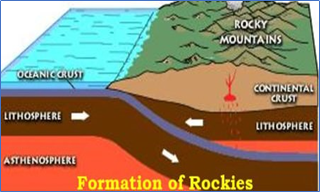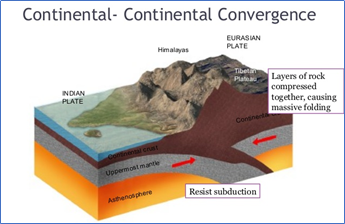Mains Daily Question
Oct. 14, 2020
- With reference to the theory of plate tectonics, explain the origin of fold mountains.
Approach
- Introduce with brief explanation of plate tectonics theory and how it forms the basis for explaining formation of fold mountains
- Explain the origin of fold mountains through plate convergence as per the plate tectonics theory - both continental-oceanic and continental-continental
- Conclude how theory explains more than just formation of fold mountains
A tectonic plate (also called lithosphere plate) is a massive, irregularly shaped slab of solid rock, generally composed of both continental and oceanic lithosphere. These plates move horizontally over the asthenosphere as rigid units. Thus, it is not the continent that moves as believed by Weigner. Continents are part of a plate and what moves is the plate.
The theory of plate tectonics identifies 7 major and 20 minor types of lithospheric plates. These plates are continuously in motion with respect to each other. These plates can be moving towards each other or away from each other, based on which the plate boundaries can be called as convergent or divergent boundaries. Fold mountains are triggered by endogenetic compressive forces and are formed at the convergent boundaries of two types: C-C Plate convergence and O-C Plate convergence, which is explained below.
Continental- Oceanic (O-C) Plate Convergence
On convergence, the heavier plate, usually the oceanic plate subsides under the lighter continental plate. This zone of subduction is called benioff zone. This subduction of heavy plate under the lighter plate cause tremendous compressional force. This compressional force compresses the sedimentary material and pushes them upwards. Thus, fold mountains are formed on the coast. Eg., The Andes and Rockies are formed by convergence of the Pacific plate with the south American and north American plates respectively.
Continental- Continental (C-C) Plate Convergence
Here again the denser plate amongst the two subsides and in the process exerts high compressional force on the other continental plate. In case of such interaction fold mountain are formed on both plates - the denser plate which subducts and well as the lighter plate. The subducted plate melts under tremendous heat and the voluminous expansion in form of magma tend to push the new formed fold mountain upwards. E.g., Himalayas are formed due to convergence of Indian plate and the Eurassian plate. Other examples are Urals mountains, Alps etc.
Not just the fold mountains, the plate techtonic theory throws light on the genesis of various landforms. It is, thus, a comprehensive theory which explains many other phenomena like Mountain building, Folding and Faulting, Continental Drift, Vulcanicity, Seismic events (earthquakes) etc.



